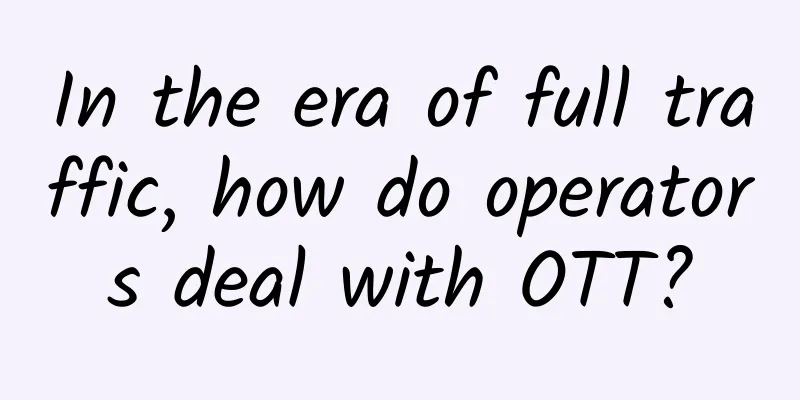In the era of full traffic, how do operators deal with OTT?

|
Introduction: WeChat's "Phone Book" and China Mobile's "Converged Communications" marked the entry of China's communications industry into the "Full Traffic Era" at the end of 2014. Are operators ready for the full traffic competition? 1. 2014 Q3 Financial Report and WeChat Phone Book On October 21, 2014, China Mobile released its third quarter financial report, with revenue increasing by 3.9% year-on-year, further declining from the previous year. The SMS business volume accelerated its decline, with a 20% drop in the first three quarters of 2014 compared with the same period last year, while in 2013 it only dropped by 1.4% compared with 2012. The total call minutes fell for the first time (call charges fell for the first time in the first half of 2013), down 0.3% year-on-year, while the same period last year increased by 3.1% year-on-year. Without checking WeChat user data or public account activity data for the same period, just look at the rising enthusiasm for information sharing based on WeChat (including voice, pictures, videos, and public account links) around you, and you will know where the lost SMS and voice have gone. The accelerated replacement of OTT for operator communication services is inevitable. Shortly after China Mobile announced that converged communications (IP-based SMS and MMS) would be piloted at the end of the year, surprising news came on Double Eleven. As if to verify the above conclusion, Tencent announced in its official account that the 1.0 version of WeChat's "Phone Book" (which has actually been available for a long time) was officially launched. Its core function is to make free calls, although it is only limited to two terminals with the "Phone Book" client installed. Although many Internet companies have previously launched similar calling and address book clients such as "Address Book" and "Incoming Calls", and even China Telecom's "YiXin" has the function of making cheap international long-distance calls, the launch of WeChat's "Phone Book" still shows a different meaning. WeChat "Phone Book" belongs to VOIP. In the past Internet era, VOIP had three modes: PC (client or webpage) to PC (client or webpage), PC to phone, and phone to phone. All kinds of PC to PC calls are not within the scope of supervision. In fact, the government's supervision is mainly on PC to phone. The third type of phone 2 phone cannot be done by Internet companies without the operator's lead. So which type does WeChat "Phone Book" phone (client) to phone (client) belong to? If the smartphone is compared to the PC, WeChat "Phone Book" essentially belongs to the first type PC (client) to PC (client), which is theoretically not within the scope of supervision. Operators have long been immune to VOIP, because the threshold of installing the client and sitting in front of the computer to make calls under the first type is a natural barrier to mobile calls. The right to open the second type of service is also in the hands of operators. As long as it is not connected to the VOIP of Internet companies, Internet VOIP cannot be implemented on mobile phones. At the same time, call charges have been reduced again and again, one-way charges, local calls and long-distance calls are the same price, and national roaming is the same price. The "long-distance calls" that VOIP has the greatest impact on have long been given to users in the competition. The only thing affected is international long-distance calls, which can be ignored in the voice revenue of operators. However, if there is a VOIP product based on smartphones that can be widely popularized and conveniently used by users, the nature of the matter will change dramatically. In China, the only IP phone product that can shake the foundation of operators is WeChat Phone Book. First, VOIP based on smartphones is no different from the existing mobile phone dialing experience, and may even have more functions. Second, similar products of other Internet companies cannot be like WeChat Phone Book, which has at least 700 million users who know about it or may try it. Considering the gimmick of "free calls", the scale of WeChat Phone Book will foreseeably grow explosively. Telecommunications operations have a strong network effect. Many years ago, the regulatory authorities disagreed with China Mobile's differentiated tariffs for both on- and off-network services in order to balance the competition between operators of unequal scale. Millions of users using the "phone book" may be a minor issue for operators, but tens of millions of users may cause bleeding, and hundreds of millions of users will directly shake the foundation of their survival. WeChat's "phonebook" and China Mobile's "converged communications" indicate that China's communications industry has entered the "full traffic era" at the end of 2014. Perhaps this sentence will be recorded in some news or report in the future. Are operators ready for the full traffic competition? 2. Operators and OTT: “Fish and Water” or “Life and Death” Recently, there are articles discussing the various possibilities of cooperation between WeChat and operators, as well as the "close relationship" between OTT and operators as described by an operator executive. This reminds me of Hegel's famous quote: "People think they are expressing a great idea when they say that human nature is good, but they forget that when they say that human nature is evil, they are expressing a much greater idea." The essence of communication services is the same as that of cars transporting goods, except that cars transport tangible goods, while communication services transport information. In order to achieve information communication, operators provide both roads (pipelines and networks) and basic passenger and freight vehicle services (calling and texting). However, in the era before 3G, most services and bearers were provided to users together. If OTT applications such as taxi-hailing, e-commerce, and payment have indeed driven the demand for operator pipelines, but have not damaged basic passenger and freight services, and have brought positive effects to operators, then social and tool applications like WeChat actually use the operator's pipeline to provide different cars, cheaper and more convenient cars. If the increase in road tolls can make up for the decline in passenger and freight traffic, everything will be harmonious. The fact is indeed shifting in this direction, but the OTT approach is in fundamental conflict with the approach that is in line with the interests of the operators themselves. Let's first look at a set of financial report data released in 2013: In 2013, China's mobile communication service revenue was 590.8 billion, voice business was 355.7 billion, accounting for 60.2%, and SMS revenue was 41.3 billion, accounting for 7%. When 2/3 of the revenue is facing the risk of being replaced, talking about N kinds of cooperation models for "fish and water joy" is tantamount to "seeking the skin of a tiger." When WeChat was first launched three years ago, China Mobile was watching, China Telecom was following suit, and only China Unicom was embracing it. It is said that a certain southern China Unicom company launched a "WeChat traffic package". Well, everyone has guessed that the "love affair" must come from China Unicom, because it is easier to talk while standing. Let's also look at a set of data released in 2013. In 2013, China Unicom's mobile communication service revenue was 155.8 billion, accounting for just over half of the total revenue (including fixed-line broadband totaling 300 billion). The advantage of full-service operation is reflected here. Among the mobile communication services that account for half, short and multimedia message revenue accounts for about 9%, and voice revenue accounts for about 40%. You can see that the advantage of 3G has led China Unicom to take the lead in making fundamental changes to its mobile communication revenue structure. The risk of OTT replacing voice and SMS is still there, but it is indeed much smaller than that of China Mobile. If N kinds of cooperation with OTT can help China Unicom snatch mobile users, it can indeed bring additional benefits. But from the perspective of the entire industry, the relationship between telecommunications operators and social and tool-based OTT applications is a "life and death" one, with competition far outweighing cooperation. Because they are essentially doing one thing, which is "moving information." "Taking the path of others and leaving them with nowhere to go" is the essence of mobile Internet, just like the replacement of ordinary letters by email and the replacement of paper media by electronic reading. The difference is that the replacement of mobile Internet does not directly bring benefits to the "initiator", so it has a certain degree of concealment. For example, if the "replaced" loses 100, 90% of it is given to users and 10 is left to itself, because the competition for users and entrances is what mobile Internet companies value most. When we listen to Internet giants talk about mobile Internet thinking such as "ultimate product experience" and "fan economy" with admiration, we often ignore the competition law hidden under the appearance of user-first: the unremitting pursuit of monopoly power. This is true for Porter's five-force competition model, and for Internet companies' monopoly on social, search, and e-commerce portals. Moreover, considering the turbulence and uncertainty of mobile Internet, mobile Internet companies' pursuit of monopoly is even greater. "Whether a monopoly is formed in a certain field" is the only criterion for judging the success of a startup, and it is also the prerequisite for whether it can go public. "Sharing" and "coexistence" do not exist, and the only results of the winner-takes-all are "dependence" and "revolution." Operators in developed countries have been challenged by Internet companies such as Skype and virtual operators in the Internet era. Therefore, in the mobile Internet OTT era, users have a certain immunity (nothing new compared to the past), and operators themselves have been tested and have the ability to cope. Operators in emerging markets are completely different. The impact of OTT applications in emerging markets will far exceed that of mature markets in terms of speed and scope. An OVUM report estimates that in 2013, OTT applications in emerging markets caused a loss of mobile voice business revenue of US$8.5 billion, and by 2018 the loss will increase to US$17.8 billion. In contrast, the cannibalization effect in developed markets is expected to be relatively mild, increasing from US$19.2 billion in 2013 to US$21.3 billion in 2018. For Chinese operators (taking China Mobile as an example), it will take at least five years to reduce the proportion of voice revenue from 60% in 2013 to less than 30% (estimated safety line) while maintaining a stable growth in total revenue. In other words, the launch of the "phone book" may not make much sense five years later. But the reality is that there is only less than a year left, and the operators are still not prepared for too many things. There is no other way. Everything is forced. We can no longer stand back and wait and see. This is a life-or-death competition. The WeChat "phone book" and the demonstration effect brought about by other Internet companies will force operators to accelerate their transformation. Whether it is the self-revolution of "convergent communications" or the expansion of growth space in all businesses and multiple fields, speed determines life (to be) or death (to be not). Don't talk about the 800 million user base. It's meaningless to have users who can't be managed and operated. Mobile phone numbers have long been jointly owned by mobile Internet companies. WeChat has occupied the SMS entrance, and WeChat Phone Book will soon occupy the dialing and address book entrance. Operators' management of users may only be SIM cards and data. Apple once told operators that they must have MicroSIM cards, and Micro SIM cards have become a standard feature since then. If one day Apple says that physical SIM cards are no longer needed and virtual SIM cards are needed, the right to choose operators or virtual SIM cards will be given to Apple. 3. Transformation goals and competitive paths in the full traffic era What is the mark of a successful operator transformation? Under the premise of keeping the user and revenue structure stable, the structure of operating revenue can be optimized, which can allow a reduction in profit margin, but cannot allow overall revenue to be unstable and cannot allow user loss. There are two scenarios to achieve revenue structure optimization. First, optimize the structure of existing individual users, increase traffic consumption, and provide services equivalent to or better than Internet IP communications to stabilize individual user ARPU. If the current operator customer ARPU is 60 yuan, they can only use 100MB of traffic (the following are all assumptions), 500 minutes of calls, and 50 text messages. The symbol of successful transformation is that the customer is still in the operator network, with an ARPU of 60 yuan, but uses 1G traffic, 2,000 minutes of calls (or unlimited local calls), 500 text messages (or unlimited), or provides other services. How to provide unlimited calls or short and multimedia messaging services at a low cost? Converged communications (IP short and multimedia messaging, IP phone) is the best choice. Second, the structure of the existing business system was optimized, and the growth of business income from all services and new areas compensated for the decline in personal communication business income. Due to the replacement of voice and short and MMS, the ARPU of individual customers dropped from 60 yuan to 30 yuan, but the fixed-line and broadband income from all services, enterprise informatization income, and new media and new advertising income compensated for the decline in personal communication income, and the overall profit and income were stable. To cope with OTT competition and successfully achieve full-traffic business transformation, both should be taken into account and the following three aspects of transformation must be completed. 1. Converged communications: the inevitable choice for leading operators The next five years will be critical for mobile operators, as more existing mobile users gain access to data services, and the migration to social communications and broader services will become more significant. Operators must make decisions about what type of service provider they want to be. Whether they want to focus on network quality and grow revenue through mobile broadband usage, or decide to keep communications as an activity driven by mobile operators. Different market competition environments and operators of different status will choose different strategies. Operators with a lagging market position may choose to cooperate with OTT (also known as alliance), because the loss of industry benefits is mainly borne by industry leaders, and the incremental mobile broadband customer revenue can bring overall revenue growth. For operators with a leading market position, they bear the main industry benefit losses and cannot achieve revenue growth by acquiring incremental customers or incremental traffic. In this case, should they passively replace the loss of revenue and lose customers or actively change the loss of revenue but retain customers? The answer is obvious. If I had some resistance to the operators’ active promotion of converged communications before, thinking it was an irrational move that would kill eight hundred enemies but hurt one thousand of my own, now everything is clear. Converged communications not only solve the IP communication problem between clients, but can also be combined with traditional communications and international communications to achieve true VOIP. For example, the “phone book” may require both parties to be in a 4G or wifi environment to have a high-quality service experience, but the operator’s converged communications only require the caller to be there, because the receiver can use the traditional communication network, a true client to phone model. Orange's Libon product is a sample of how leading operators respond to OTT. Some reports claim that the benefits Libon brings to operators can offset the cannibalization effect on communication services. Orange Libon has been developing continuously since 2011. In the early stage, it focused on voice and voicemail, and later added communication components, allowing it to directly compete with services such as Whatsapp, Viber and even Skype. Orange once gave a case in which it adopted the Libon international calling plan for Sosh, a low-cost fixed-line and mobile phone brand, which increased Sosh's incoming international call traffic by 21% (outgoing calls will definitely be very cheap) and increased the traffic per user by 250 minutes. At the same time, the usage of competitors' services all decreased, including Skype's 10% decrease and Viber's 79% decrease. Libon is currently available in more than 100 countries, and the user base is constantly expanding. Not much is known about the specific case content, but Libon, mentioned in many reports, should be a reference for operators' RCS applications. For China Mobile, since it has decided to face the competition through converged communications, the remaining issue is speed and experience (from the perspective of the operator, I am very worried). If it relies too much on terminal prefabrication and outsourcing, it will seriously affect the speed of product iteration and experience. Orange has its own patented open chat technology, which is applied to Libon, allowing users to communicate instantly with all contacts. A Libon chat session only requires a mobile phone, tablet or computer with an HTML5 browser. Libon users send a chat link to a contact, and the contact can initiate an IM session by opening the link. The chat link will be locked to the Libon user's device. I heard that China Mobile has already completed the bidding for the cooperation partners of converged communications. I really can't understand why operators can't really develop and operate software products by themselves? I learned that a certain provincial mobile company in central China once launched an instant messaging service "Hexin" for corporate users, which was developed by six employees of its ICT department. It also has hundreds of thousands of users and provides support to other provinces. If the employees of operators are really only suitable for service marketing or business management, then there is no need to complain, because their value is so limited that they are only worthy of standing aside and envying and hating Internet companies. (II) Rates and billing system for full-flow operations If I were the person in charge of market operations of a provincial company (I am imagining this), regardless of whether converged communications will be launched, it is time to study and formulate full-flow tariff packages (because market trends require it). Full-flow tariff packages should be as follows: monthly fee of 200 yuan (it is recommended to give priority to mid- to high-end customers), including *G traffic, unlimited domestic network calls (unlimited as long as they do not involve inter-network settlement), and unlimited point-to-point SMS and MMS (or set a larger upper limit in accordance with the requirements for spam SMS prevention, such as 10,000 messages). The logic of the full traffic package is that since voice and SMS and MMS are IP-based, the voice and MMS traffic is meaningless, and only traffic remains. At the same time, since users can use third-party clients to achieve free SMS and free calls, why not keep the traffic in the network? If keeping it in the network involves increasing network element investment, of course, it needs to be considered differently, but looking back at the third quarter financial report data, China Mobile's total call minutes fell year-on-year for the first time. Network capacity is designed according to a certain growth ratio. As long as the traffic volume starts to decline, the downward trend is inevitable. It is certain that there is spare capacity for traffic, and the same is true for SMS gateways. Instead of leaving it idle, it is better to package it very cheaply and give it to users. If I were the person in charge of market operations at a provincial company (I’m just kidding again), it would be time to overthrow the existing support system and establish a support system with traffic management as the core. First, learn from the virtual operator Alibaba (the full-traffic package launched in May is a template). In the full-traffic era, there are no more calls and text messages. The traditional billing model based on call duration and text message volume cannot adapt to the requirements of the times. Customers should be allowed to flexibly convert traffic into calls and short and multimedia messages, and they should also be allowed to flexibly convert the remaining short and multimedia messages and calls in the package into traffic. Secondly, the existing forward general traffic billing model is not suitable for the full traffic competition requirements. The current amount of RMB for a certain amount of MB of traffic is only one form of traffic billing, and it is also the simplest form. Then there are the following types of traffic models. How many companies are ready? Forward directional traffic: Differentiated tariffs (not free) are set for specific Internet applications. For example, for video services related to operator strategy, a traffic tariff of 1 yuan for 50MB can be set, but the traffic fee is still charged to users. Backward unified payment of traffic. For example, in order to encourage customers to use online banking and promote client applications, a commercial bank can tell the operator that all traffic accessing the bank's designated client applications within a short period of time will be paid by the bank and will not be charged to users. Traffic distribution and transfer. If an Internet company promotes a "carpooling" client application, it purchases 1 million MB of traffic from an operator, but does not consume it itself. Instead, it gives it to customers as a promotion. It promises customers that as long as they download and register to log in to the carpooling client application, they will be given 100 MB of traffic (expected to develop 10,000 customers). The data traffic payment cooperation between Alibaba and Guangdong Mobile in 2013 was a backward data traffic payment. Guangdong Mobile's WeChat data traffic red envelope in early 2014 was actually a specific form of data traffic distribution and transfer, because its main body was the operator, not a general enterprise or user. Operators' heavy billing systems, outdated business models, and rigid product designs (such as clearing at the end of the month) cannot support the Internet-based practice of traffic. To achieve the separation of volume and cost, make traffic a resource and commodity, and freely convert/trade it as an "Internet" resource among OTT/consumers, it is necessary to reconstruct the current support system and make a new transformation from traffic billing data collection (collection network element points), control to support (billing, CRM, BI). (III) All business and all fields In 2013, the Ministry of Industry and Information Technology issued full-service licenses while issuing TD-LTE 4G licenses. For example, China Mobile can officially (not relying on China Railway Communications) operate fixed-line and broadband services. As mentioned above, China Mobile, which focuses on mobile communications operations, is suffering more from OTT competition. It's just that the main target of full-service competition in the communications industry is competitors in the industry, but for China Mobile, compared with Internet companies, competitors in the industry are obviously more familiar and easier to deal with. In the foreseeable future, fixed-line (IMS), broadband, and enterprise informatization will provide strong support for China Mobile's revenue structure optimization. The above only refers to the full business within the scope of communications. The real full business should be in all fields. Invest wherever you can make money and do whatever you can do to survive (under the premise of legality). Don’t worry about whether you are dominant or decent. Here I would like to give an example of Taiwan’s Far EasTone Telecommunications. Competition in Taiwan's telecommunications industry is very fierce. There are about six or seven operators, of which only the top three are truly profitable. The third one is Far EasTone Telecommunications. In order to survive, it does almost everything, such as equity cooperation with game and entertainment companies to develop data content. Its agency in China ranks among the top in the CP scale of China Mobile's music base and game base. At the same time, it also cooperated with a local company in Jiangsu to explore the joint construction of service halls, and actively expressed its desire to break through the policy restrictions on resale business and become a virtual operator of China Mobile (currently resale business is limited to private enterprises in mainland China). The premise of the above-mentioned full-field competition is that enterprises truly return to the market. Is there any hindrance in the existing state-owned control mechanism? Can the mentality of existing state-owned enterprise employees bear it? These are difficult to avoid questions. IV. Summary Operators have been working hard to cope with OTT competition, and the above three changes are being implemented to varying degrees. However, the early arrival of the full-traffic era has inevitably disrupted the plans of operators. Competition has become more naked and cruel, and transformation has become more urgent than ever. A forced "self-revolution" campaign is about to begin. We will have to wait and see what the result will be. As a winner of Toutiao's Qingyun Plan and Baijiahao's Bai+ Plan, the 2019 Baidu Digital Author of the Year, the Baijiahao's Most Popular Author in the Technology Field, the 2019 Sogou Technology and Culture Author, and the 2021 Baijiahao Quarterly Influential Creator, he has won many awards, including the 2013 Sohu Best Industry Media Person, the 2015 China New Media Entrepreneurship Competition Beijing Third Place, the 2015 Guangmang Experience Award, the 2015 China New Media Entrepreneurship Competition Finals Third Place, and the 2018 Baidu Dynamic Annual Powerful Celebrity. |
>>: Operators should use VoLTE to compete with WeChat Phonebook
Recommend
Teach you how to make money with Douyin from scratch - techniques to attract fans and monetize
Tik Tok - the second wave of short video populari...
Feeding a Tibetan brown bear privately causes it to rush towards tourists? It's really a life-threatening move!
Recently, a video of a Tibetan brown bear chargin...
The tent is made of 100 tiger skins, the only one of its kind in the world
In the Ganzi Tibetan Autonomous Prefecture Museum...
Is walking and stopping more effective in losing weight than walking all the time? | Technology Weekly
Compiled by Zhou Shuyi and Wang Xiang Ten years a...
NIO plans to issue 160 million American depositary shares at a price range of $6.25 to $8.25
According to foreign media reports, NIO submitted...
Today is the Great Cold丨We snuggle together beside the warm stove in winter and look forward to the return of spring with you!
"The sky and river are clearing away the nig...
A man died after extracting 23 teeth at once! Can you only extract one tooth at a time?
When it comes to tooth extraction, everyone is fa...
"Dangal!" How to make Dad a hit through word of mouth? We have summarized 4 key techniques
" Dangal!" " Dangal " is the ...
"Catch" lightning, turn it into energy, storage is the key!
On September 15, affected by strong thunderstorm ...
Technology Morning News | Man-made spacecraft touches the sun for the first time
News Station Photo by Xinhua News Agency reporter...
Microsoft how-old: What exactly "betrays" our age?
During the May Day holiday, Microsoft's how-o...
New fabric allows secure payments and health monitoring with a swipe of the sleeve
With the rapid development of science and technol...
Advertising suggestions during the epidemic period!
During this special Spring Festival holiday, the ...
World Hate Cilantro Day丨Does cilantro smell good or bad to you?
Science Fiction Network, February 24 (Xu Mingyang...
Why is everyone fleeing Windows 10?
About two weeks ago, Microsoft released Win10 SDK...









